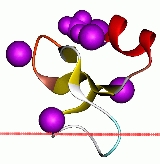
Beta defensin
Encyclopedia
Beta defensins are a family of mammalian defensin
s. The beta defensins are antimicrobial peptides
implicated in the
resistance of epithelial surfaces to microbial colonization.
Defensins are 2-6 kDa, cationic, microbicidal peptides active against many Gram-negative and Gram-positive bacteria, fungi, and enveloped viruses, containing three pairs of intramolecular disulfide bonds. On the basis of their size and pattern of disulfide bonding, mammalian defensins are classified into alpha, beta and theta categories. Every mammalian species explored thus far has beta-defensins. In cows, as many as 13 beta-defensins exist in neutrophils. However, in other species, beta-defensins are more often produced by epithelial cells lining various organs (e.g. the epidermis, bronchial tree and genitourinary tract).
Human, rabbit and guinea-pig beta-defensins, as well as human beta-defensin-2 (hBD2), induce the activation and degranulation of mast cells, resulting in the release of histamine and prostaglandin D2.
The first human beta-defensin, HBD1, was discovered in 1995, followed by the HBD2 in 1997.
; DEFB105A
; DEFB105B; DEFB108B; DEFB109; DEFB110; DEFB111;
DEFB114; DEFB130; DEFB136; DEFB4; SPAG11A;
Defensin
Defensins are small cysteine-rich cationic proteins found in both vertebrates and invertebrates. They have also been reported in plants. They are, and function as, host defense peptides. They are active against bacteria, fungi and many enveloped and nonenveloped viruses. They consist of 18-45 amino...
s. The beta defensins are antimicrobial peptides
Antimicrobial peptides
Antimicrobial peptides are an evolutionarily conserved component of the innate immune response and are found among all classes of life. Fundamental differences exist between prokaryotic and eukaryotic cells that may represent targets for antimicrobial peptides...
implicated in the
resistance of epithelial surfaces to microbial colonization.
Defensins are 2-6 kDa, cationic, microbicidal peptides active against many Gram-negative and Gram-positive bacteria, fungi, and enveloped viruses, containing three pairs of intramolecular disulfide bonds. On the basis of their size and pattern of disulfide bonding, mammalian defensins are classified into alpha, beta and theta categories. Every mammalian species explored thus far has beta-defensins. In cows, as many as 13 beta-defensins exist in neutrophils. However, in other species, beta-defensins are more often produced by epithelial cells lining various organs (e.g. the epidermis, bronchial tree and genitourinary tract).
Human, rabbit and guinea-pig beta-defensins, as well as human beta-defensin-2 (hBD2), induce the activation and degranulation of mast cells, resulting in the release of histamine and prostaglandin D2.
The first human beta-defensin, HBD1, was discovered in 1995, followed by the HBD2 in 1997.
Human proteins containing this domain
DEFB1; DEFB103ADEFB103A
Beta-defensin 103 is a protein that in humans is encoded by the DEFB103A gene.-Further reading:...
; DEFB105A
DEFB105A
Beta-defensin 105 is a protein that in humans is encoded by the DEFB105A gene.-Further reading:...
; DEFB105B; DEFB108B; DEFB109; DEFB110; DEFB111;
DEFB114; DEFB130; DEFB136; DEFB4; SPAG11A;

